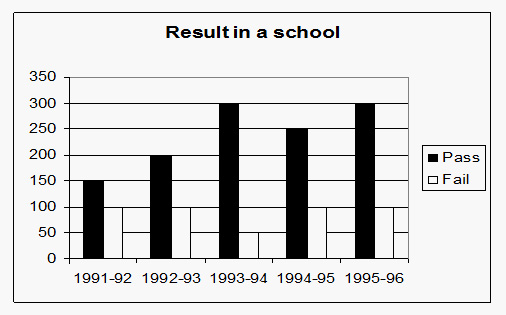Let us see how to remember easily the marks of every student in all subjects using bar graphs. Suppose your teacher wants to show the comparison of the marks of students in all subjects, then it will take more time for comparing all subjects, to avoid this problem we can use bar graphs concept. In this platform, we can easily learn the bar graph definition, construction of a bar graph, advantages of bar graph, and examples.
We learned that a bar chart is beneficial for comparing facts. The bars provide a visible display for comparing quantities in several categories. Bar graphs can have horizontal or vertical bars. In this lesson, we’ll show you the steps for constructing a bar chart.
Also, Read:
Bar Graph – Definition
Bar graphs are defined as the pictorial representation of data, it’s within the sort of vertical rectangular bars or horizontal rectangular bars, where the length of bars are proportional to the measure of data. Bar graphs are also called as Bar charts, it is one for data handling in statistics.
Types of Bar Graphs
There are two types of bar graphs, those are namely
- Horizontal Bar Graphs
- Vertical Bar Graphs
Uses of Bar Graphs
- Bar graphs are match things between different groups or trace changes over time. when trying to estimate change over time, bar graphs are best suitable when the changes are bigger.
- Bar charts possess a discrete domain of divisions and are normally scaled so that all the information can fit on the graph. When there’s no regular order of the divisions being matched, bars on the chart could also be organized in any order.
- Bar charts organized from the high to the low number are called Pareto charts.
Properties of Bar Graphs
Bar graphs are used for pictorial representation of the data. Some of the properties of Bar Graphs are listed below,
- In Bar graphs, each column or bar in a bar graph is of equal width.
- All bar graphs bars have a common base.
- The height of the bar corresponds to the worth of the information.
- The distance between each bar is the same.
Advantages of Bar Graphs
The important advantages of the bar graphs are given below and they are along the lines,
- Bar graphs are easily understood because of widespread use in business and therefore the media.
- Bar graphs show each data category during a frequency distribution.
- It summarizes an outsized data set in visual form.
- A bar chart is often used with numerical or categorical data.
- Bar graph permits a visual check of accuracy.
How to Construct Bar Graph? | Steps to Make a Bar Graph

To represent the information using the bar graph, you need to follow the steps given below.
Step 1: First, keep the title of the bar graph or bar chart.
Step 2: Next, Draw the vertical axis and horizontal axis.
Step 3: Now, we can label the horizontal axis.
Step 4: Write the horizontal axis names.
Step 5: Now, label the vertical axis.
Step 6: Finalise the size range for the given data.
Step 7: Finally, draw the bar graph that ought to represent each category of the information with their respective numbers.
Bar Graph Construction Examples
Let us consider an example, we have four different years of population, such as 1991, 1992, 1993,1994 and the corresponding percentages are 82, 85, 90, and 92 respectively.
To visually representing the given information using the bar graph, we need to follow the steps given below.
Step 1: First, fix the title of the bar chart or bar graph.
Step 2: Draw the horizontal axis and vertical axis. (write, population years)
Step 3: Now, label the horizontal axis.
Step 4: Write the names on the horizontal axis, such as 1991, 1992, 1993, 1994
Step 5: Now, label the vertical axis. (write percentage)
Step 6: Finalise the size range for the given data.
Step 7: Finally, draw the bar graph that should represent each year’s population with their respective percentages.
Example 1:
Study the subsequent graph carefully and answer the questions that follow. The results of students in a school graph are as shown

1. What is the difference in the number of students who passed to those who failed is minimum in which year?
2. How many times the number of students are failed as same?
3. What percentage will increase within the total number of students maximum as compared to the previous year?
4. What is the approximate percentage of students who failed during 5 years?
Solution:
Given the results of student in a school in the form of a bar graph
Now we can find the given questions,
(i) In these, first find the difference in all the years
The difference between the number of students passed to those who failed in the year 1991 – 1992 is,
=150 – 100 = 50
The difference between the number of students passed to those who failed in the year 1992 – 1993 is,
=200 – 100 = 100
The difference between the number of students passed to those who failed in the year 1993 – 1994 is,
=300 – 50 = 250
The difference between the number of students passed to those who failed in the year 1994 – 1995 is,
=250 – 100 = 150.
Therefore, considering all the difference the minimum number of students passed to those who failed is, in the year 1991 – 1992 = 50.
(ii) In this, we find the number of times students failed as same,
Based on the observation number of failed students are the same in the years 1991- 1992, 1992- 1993, 1994- 1995, and 1995- 1996.
Therefore, the number of failed students is the same as are Four times.
(iii) In this we are finding how much percentage will be increased compared to the previous year.
Firstly we can find the percentage of every year,
In the year 1992- 1993, percentage(%) increase is
= 100 x (300 – 250) / 250 = 100 x (50)/ 250 = 20%
In the year 1993- 1994, percentage(%) increase is
= 100 x (350 – 300) / 300 = (50 / 3)% = 16.6%
In the year 1994- 1995, percentage (%) increase is,
= 100 x (350 – 350) / 350 = 0%
In the year 1995-1996, percentage(%) increase is
= 100 x (400 – 350) / 350 = 100 x (50)/350 = 14.2%.
Therefore, considering all the percentage 20% is higher than the previous year.
(iv) In this we are finding the total number of failed students,
The total number of failed students is,
= 50+100+100+100+100 = 450
Therefore, the Required average of students is = 450/5 = 90.
FAQs on Construction of Bar Graph
1. What are the various types of Bar graphs?
Bar graphs are of two types, namely:
- Horizontal Bar Graph
- Vertical Bar Graph
Based on these two types, again bar graphs are two types
- Grouped Bar Graph
- Stacked Bar Graph
2. List the advantages of a Bar Graph?
- Bar graphs are easily understood due to widespread use in business and therefore the media.
- It summarizes an outsized data set in visual form.
- A bar chart is often used with numerical or categorical data.
- Bar graph permits a visual check of accuracy.
3. How do you calculate a bar graph?
Draw two perpendicular lines intersecting each other at a point O. The vertical line is that the y-axis and therefore the horizontal is that the x-axis. Choose an appropriate scale to work out the peak (height) of every bar. On the horizontal line, draw the bars at equal distances with corresponding heights.
